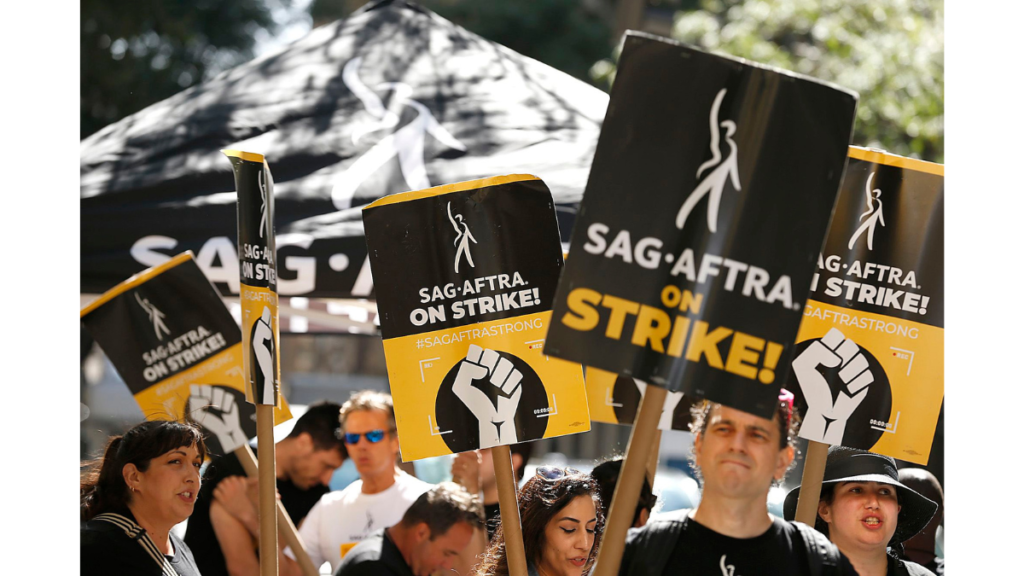The Screen Actors Guild-American Federation of Television and Radio Artists (SAG-AFTRA) is a powerful union in the entertainment industry, representing performers, journalists, and others. The union’s primary goal is to protect and improve working conditions, pay, and other conditions of its members. SAG-AFTRA has a long history of striking, starting with a significant walkout in 1945 in Hollywood for a larger cut of revenues from the growing television industry. The power of collective bargaining in the entertainment industry is attributed to the union’s members, who make up a significant proportion of the labor force. Recent high-profile SAG-AFTRA strikes include the Video Game Voice Actor Strike (2016), the Commercial Strike (2000-2003), and the Streaming Residuals Strike (2021). These strikes have raised awareness of critical concerns and resulted in concrete improvements to the working conditions and pay of striking employees. However, SAG-AFTRA faces challenges in accommodating a wide variety of members’ preferences, keeping up with rapid changes in the entertainment business, and embracing innovative technologies. The future of SAG-AFTRA strikes will depend on its ability to adapt to changing conditions and address member concerns.
What is SAG-AFTRA?
Screen Actors Guild-American Federation of Television and Radio Artists (SAG-AFTRA) was formed in 2012 and is now one of the most influential unions in the entertainment industry. The media industry is well-represented, including performers, journalists, and others. The union’s primary goal is to protect and improve the working conditions, pay, and other conditions of its members.
A History of Strikes
SAG-AFTRA has a long history of striking. Strikes and labor disputes litter the entertainment industry’s history, demonstrating the difficulties performers and media workers have always faced. The Screen Actors Guild (SAG), founded in 1933, was instrumental in the beginning of many of these strikes.
In 1945, Hollywood saw one of the most significant strikes ever. The actors went on strike because they wanted a bigger cut of the revenues from the growing television industry. The walkout, lasting for nearly a month, was a key milestone in labor history, finally leading to improved working conditions and compensation for actors.
The Power of Collective Bargaining
The capacity of the SAG-AFTRA strike to influence the entertainment industry can be attributed, in large part, to the effectiveness of collective bargaining. Union members make up a sizable proportion of the industry’s labor force, and when they come together for a single cause, they may have considerable influence in bargaining.
Recent SAG-AFTRA Strikes
SAG-AFTRA has gone on a number of high-profile strikes in recent years. Notable examples include the following:
Video Game Voice Actor Strike (2016): SAG-AFTRA members who work as voice actors in video games went on strike to improve their pay and working conditions. After the strike, a new contract was negotiated that protected voice actors from harmful vocal stress and paid them fairly.
Commercial Strike (2000-2003): The SAG strike lasted over three years, making it one of the longest in the organization’s history. The main reason was that people were upset over commercial actor pay. Actors’ pay and residuals are better now thanks to the strike.
Streaming Residuals Strike (2021): SAG-AFTRA has negotiated with major streaming platforms to ensure that actors receive a fair part of the cash earned by their work as the streaming industry has grown. The strike led to a more reasonable system of payment for performers in the modern digital era.
Impact on the Entertainment Industry
It’s impossible to emphasize how much damage SAG-AFTRA strikes have done to the entertainment business. These walkouts have not only raised awareness of critical concerns, but also resulted in concrete improvements to the working conditions and pay of striking employees.
Challenges Faced by SAG-AFTRA
Strikes by SAG-AFTRA have been effective in many areas, but they have not been without their share of difficulties. Constant problems include accommodating a wide variety of members’ preferences, keeping up with rapid changes in the entertainment business, and embracing innovative technologies.
The Future of SAG-AFTRA Strikes
SAG-AFTRA will adjust its tactics and priorities as the entertainment business develops more. The union’s capacity to adapt to changing conditions and address the concerns of its members will determine its future success in striking for fair terms.
Conclusion
The entertainment industry would not look the same without the improvements in working conditions and pay that were brought about by SAG-AFTRA strikes. These walkouts show how effective collective action and negotiating can be in a sector as fluid and unpredictable as the labor market.
SAG-AFTRA has been and will continue to be a powerful force in the entertainment industry, fighting for the rights and well-being of the people who bring tales to life on film and on broadcast. SAG-AFTRA’s strikes will continue to be a driving force for change in the entertainment industry, whether that change is the negotiation of fair compensation, improved working conditions, or the adaptation to the digital age.
Read More : rubblemagazine.com







